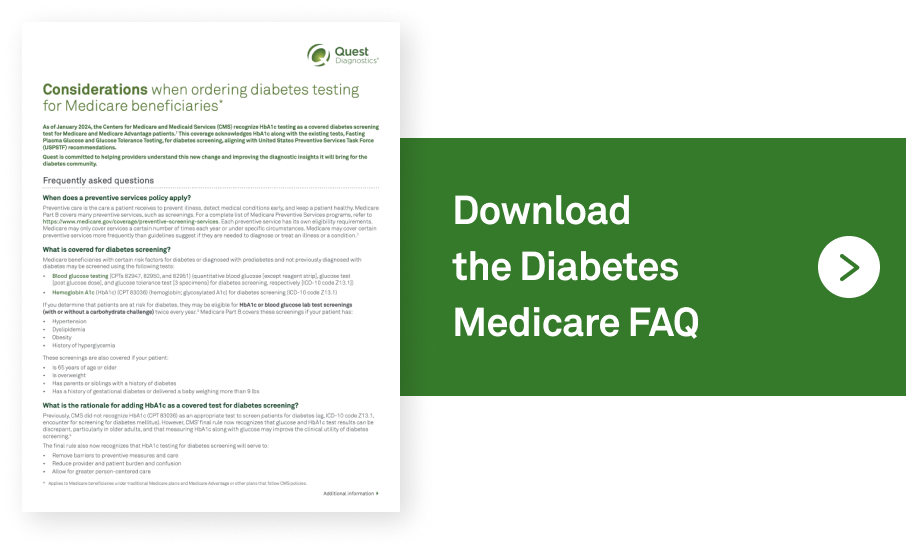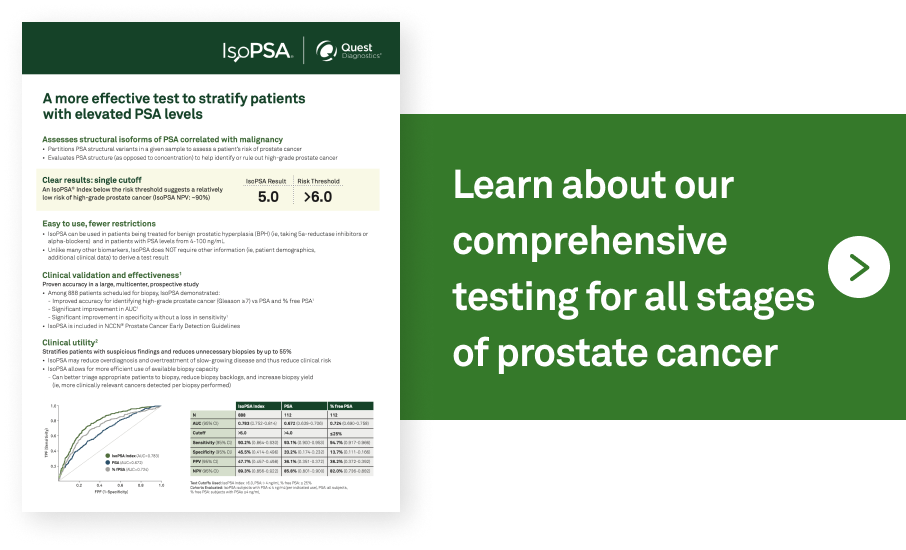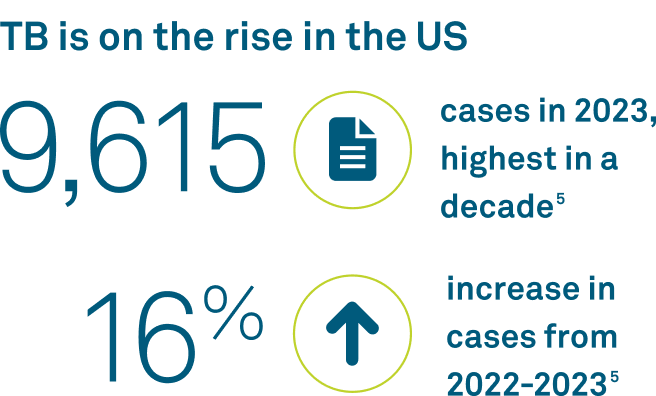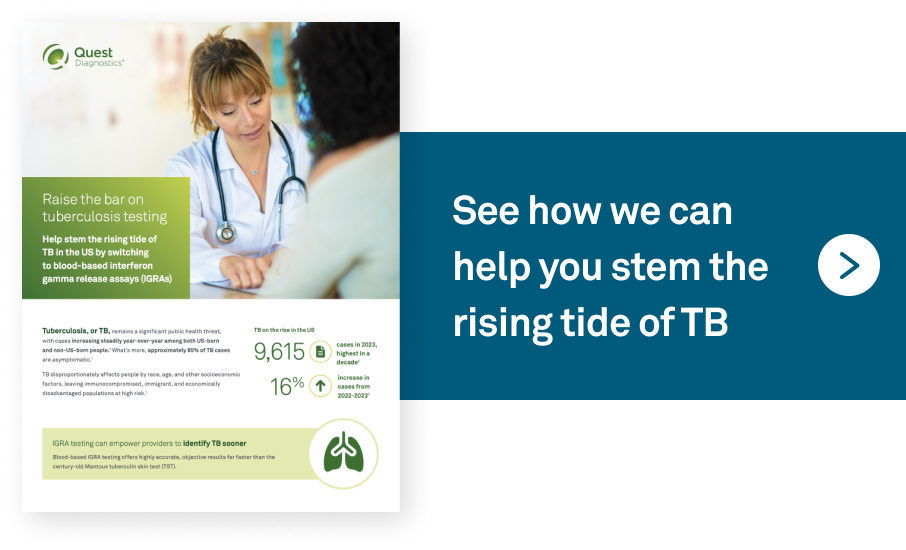November 2024

Discoveries, trends, and discussions in diagnostics
1) November is American Diabetes Month®: Let’s work together to identify patients at risk earlier
2) Improving glycemic control: Update to HbA1c screening policy, new T1D guidance
3) Raising awareness of men’s health issues this Movember®
4) Talk about prostate cancer risk
5) Raise the bar on TB testing with blood-based IGRA testing
6) Help patients celebrate the holidays safely with respiratory combination testing
|
|
November is
|

|
November is
|

|
November is
|
November is
|
Let’s work together to identify patients at risk earlier
In 2021, 38.1 million adults age 18 years or older—or 14.7% of all US adults—had diabetes,1 and its prevalence may increase by 54% to more than 54.9 million Americans by 2030.2
These statistics emphasize the importance of identifying patients at risk for diabetes earlier. In recognition of American Diabetes Month, we’re highlighting 2 important policy and guideline updates that happened in 2024 that remove barriers to testing.
- The Centers for Medicare and Medicaid Services (CMS) updated their diabetes screening policy to cover HbA1c testing
- The American Diabetes Association® published new guidance for monitoring patients with T1D
Read the article below for more insights.

|
Better outcomes |
Better outcomes |
Improving glycemic control: Update to HbA1c screening policy, new T1D guidance
- Is 65 years of age or older
- Is overweight
- Has parents or siblings with a history of diabetes
- Has a history of gestational diabetes or delivered a baby weighing more than 9 lbs
- Blood glucose testing
- HbA1c testing
|
|
In a recent podcast, Quest experts Kenneth French, senior clinical consultant, and Dr Maeson Latsko, clinical and education specialist, explored insulin resistance and highlighted tools, including the Cardio IQ® Insulin Resistance Panel with Score, that can help identify diabetes risk early, enabling actions that may prevent or even reverse the onset of this chronic illness. |

- Clear, actionable advice on how to follow up during the early, preclinical stages of T1D
- Specific advice to care for children, adolescents, and adults (including educational and psychosocial advice)
- Emphasis on the benefits of early detection of T1D, including reduced risk of diabetic ketoacidosis at diagnosis, increased planning and preparation time, and the opportunity to consider research aimed at delaying and preventing T1D
Raising awareness of men’s health issues this Movember®
Talking about prostate cancer risk

- Age 50 for men at average risk of prostate cancer who are expected to live at least 10 more years
- Age 45 for men at high risk of prostate cancer, including all Black men and any man with a father or brother diagnosed with prostate cancer before age 65
- Age 40 for men at even higher risk, including men with more than one brother or both a father and brother who had prostate cancer, and men who carry a pathogenic mutation in BRCA1 or BRCA2

|
Better experiences |
Better experiences |
Raise the bar on TB testing with blood-based IGRA testing
Help patients celebrate the holidays safely with respiratory combination testing

|
Removing traditional barriers to testing |

|
Removing traditional barriers to testing |
Removing traditional barriers to testing |
Provide answers to patients at risk for HIV
- Everyone age 13-64 should be tested at least once
- People at higher risk of acquiring (or exposure to) HIV should be tested at least annually
- Sexually active gay and bisexual men may benefit from more frequent testing (eg, every 3-6 months)
Achieving the Quadruple Aim in your practice
About Diagnostics Dialogue
- CDC. Future surge in diabetes could dramatically impact people under 20 in US. December 29, 2022. Accessed October 9, 2024. https://www.cdc.gov/media/releases/2022/p1229-future-diabetes-surge.html
- Rowley WR, Bezold C, Arikan Y, et al. Diabetes 2030: Insights from yesterday, today, and future trends. Popul Health Manag. 2017;20(1):6-12. doi:10.1089/pop.2015.0181
- American Diabetes Association. Statistics about diabetes. Accessed October 22, 2024. https://diabetes.org/about-diabetes/statistics/about-diabetes
- American Cancer Society. Cancer facts for men. Updated October 31, 2023. Accessed October 9, 2024. https://www.cancer.org/cancer/risk-prevention/understanding-cancer-risk/cancer-facts/cancer-facts-for-men.html
- Williams PM, Pratt RH, Walker WL, et al. Tuberculosis—United States, 2023. MMWR Morb Mortal Wkly Rep. 2024;73(12):265-270. doi:10.15585/mmwr.mm7312a4
- Shah I, Kathwate J, Shetty, NS. Comparison of tuberculin skin test and QuantiFERON-TB Gold In-Tube test in Bacillus Calmette-Guerin-vaccinated children. Lung India. 2020; 37(1):24-29. doi:10.4103/lungindia.lungindia_304_19
- Hartman-Adams H, Clark K, Juckett G. Update on latent tuberculosis infection Am Fam Physician. 2014;89(11):889-896. Published correction appears in Am Fam Physician. 2014;90(7):434. https://www.aafp.org/pubs/afp/issues/2014/0601/p889.html
- CDC. 2024-2025 respiratory disease season outlook. August 29, 2024. Accessed October 9, 2024. https://www.cdc.gov/cfa-qualitative-assessments/php/data-research/season-outlook24-25/index.html
- Hanson KE, Azar MM, Banerjee R, et al. Molecular testing for acute respiratory tract infections: clinical and diagnostic recommendations from the IDSA’s diagnostics committee. Clin Infect Dis. 2020;71(10):2744-2751. doi:10.1093/cid/ciaa508
- HIV.gov. US statistics. Updated August 15, 2024. Accessed October 9, 2024. https://www.hiv.gov/hiv-basics/overview/data-and-trends/statistics
- CDC. Clinical testing guidance for HIV. September 10, 2024. Accessed October 9, 2024. https://www.cdc.gov/hivnexus/hcp/diagnosis-testing/index.html
- CDC. Fast facts: HIV in the US. April 22, 2024. Accessed October 9, 2024. https://www.cdc.gov/hiv/data-research/facts-stats/index.html








